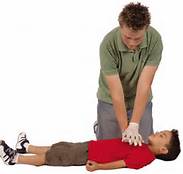Author:
|
Back to Blog
7 Common Myths about CPR – Debunked2/1/2015  For centuries, sudden death from cardiac arrest was virtually inevitable. In 1960, CPR was developed to revive unresponsive victims of sudden cardiac arrest. The American Heart Association now trains more than 12 million people in CPR annually, yet only around 92% of out-of-hospital cardiac arrest victims survive. In order to increase cardiac arrest victim survival rates and educate the public about the importance of emergency medical care, it’s critical to separate CPR facts from myths. Here are some of the most common myths about CPR and First Aid certification, debunked. 1. You can get sued if you perform bystander CPR If you provide emergency medical assistance with First Aid, CPR, or an AED, Good Samaritan laws will protect you, as long as you act reasonably and prudently. In cases where the rescuer was negligent, reckless, or abandoned the victim after providing initial care, courts have ruled that the Good Samaritan law did not apply, however. 2. You can kill someone if you perform CPR incorrectly CPR will only help a victim of cardiac arrest, whether or not it’s not performed perfectly. It’s better to perform CPR imperfectly than not at all. 3. You can get a First Aid and CPR Certification online While it’s true that you can complete modules of First Aid and CPR certification courses online, you must complete an in-person skills session in order to receive a certification. Students are unable to experience the delivery of physical skills from a computer, so eLearning is only effective when it’s combined with in-person skills training. There are many CPR training courses that supposedly provide an “instant” online CPR certification, but none of these certifications would meet the requirements of an employer. 4. If you are alone with a victim and haven’t been trained in CPR, you shouldn’t attempt to perform CPR The American Heart Association recommends that untrained bystanders perform compression-only CPR to “buy time” until emergency medical personnel arrive. When you call 911, the dispatcher will give you instructions over the phone on how to do chest compressions. 5. CPR classes are long and boring If you take the time to choose an experienced instructor who teaches engaging classes, First Aid and CPR certification courses can actually be quite enjoyable. American Heart CPR courses only last a few hours, so time will pass quickly if you choose the right instructor. 6. You can contract HIV/AIDS from performing CPR Many people are reluctant to perform conventional CPR with mouth-to-mouth resuscitation because they are scared that they will contract HIV/AIDS, but the risk of this happening is minimal. HIV/AIDS can only be spread through direct contact with blood, semen, or vaginal fluid. If you’re still worried about it, you can always carry a special barrier device around with you in case you ever have to perform CPR. You can also perform compression-only CPR instead. 7. CPR always works Movies and TV would have you believe that CPR works every time, but the actual success rate for CPR is somewhere between 5 and 10% for adults, depending on how soon it is performed after the victim’s collapse. Nevertheless, learning to perform CPR is critical because it can double or triple a victim’s chance for survival. So give us a call to get your class on the books (503) 538-2610 or www.cprnorthwest.com
0 Comments
Read More
Your comment will be posted after it is approved.
Leave a Reply. |

 RSS Feed
RSS Feed